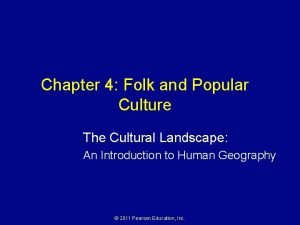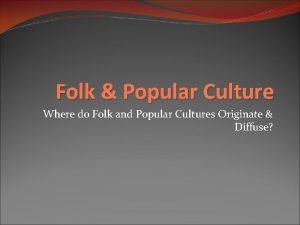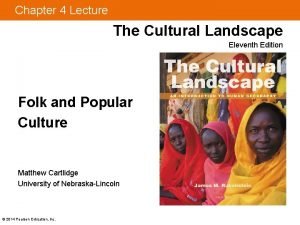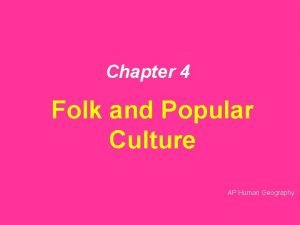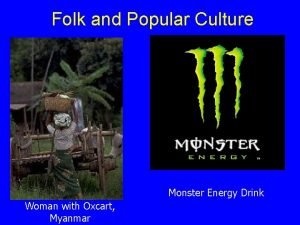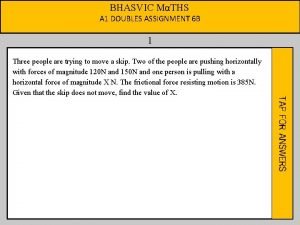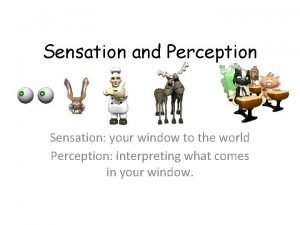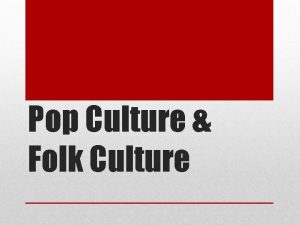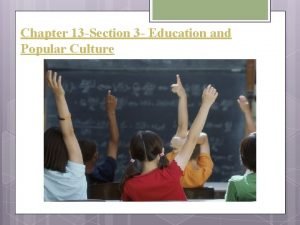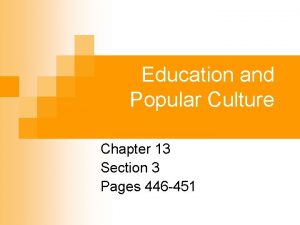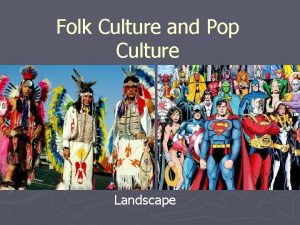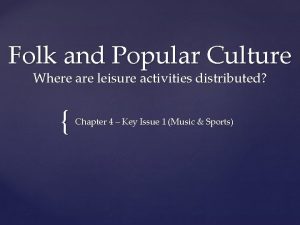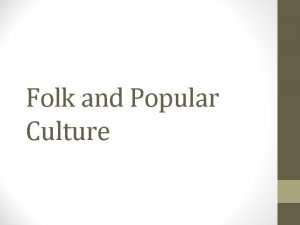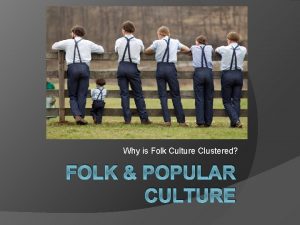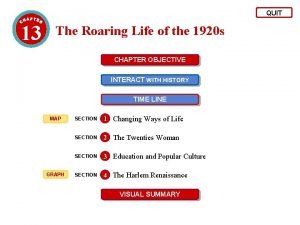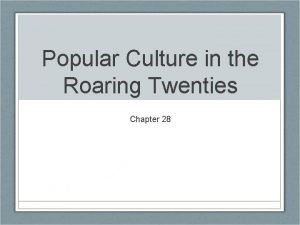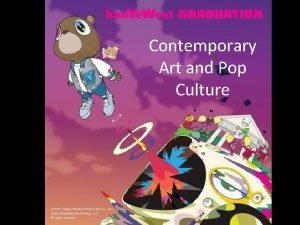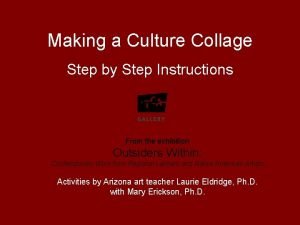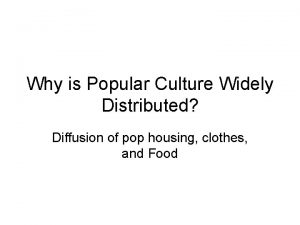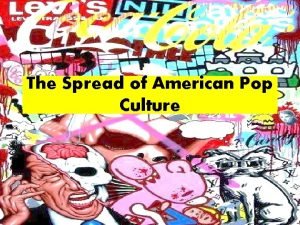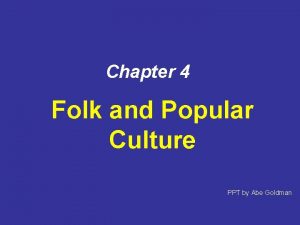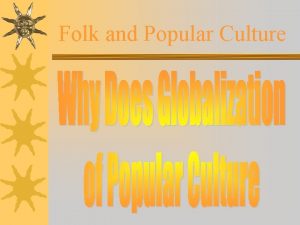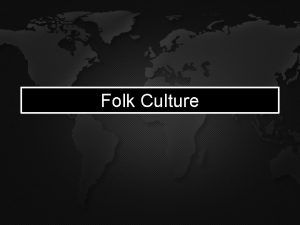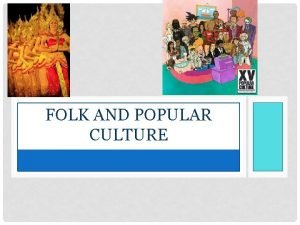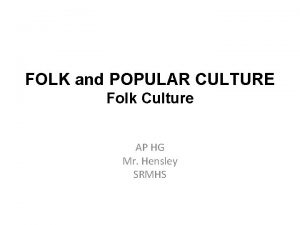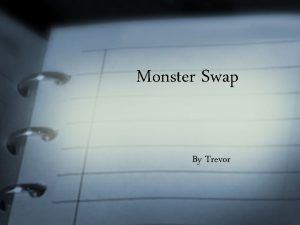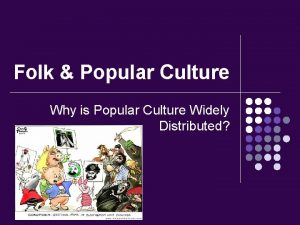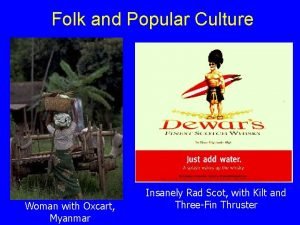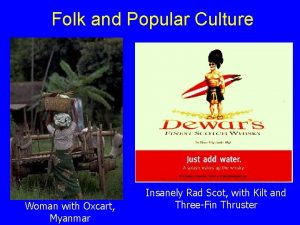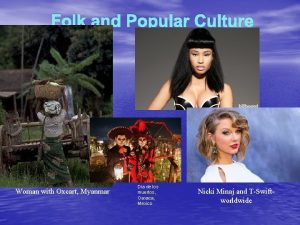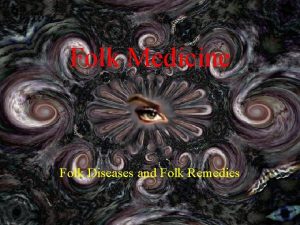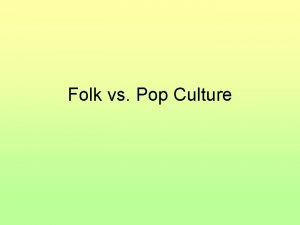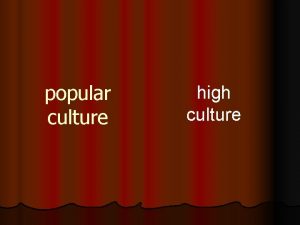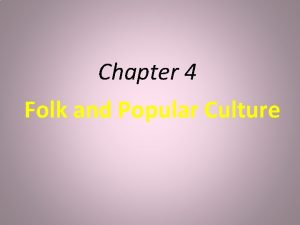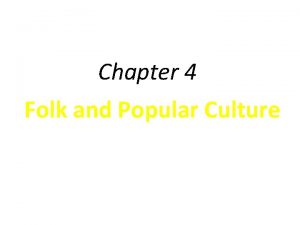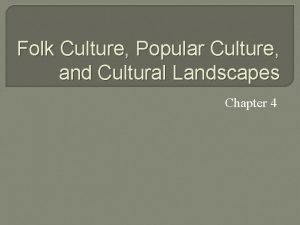Folk and Popular Culture Monster Energy Drink Woman








































- Slides: 40

Folk and Popular Culture Monster Energy Drink Woman with Oxcart, Myanmar

Seoul, SK Nov 2009


Beijing, China

Important Terms • Custom – frequent repetition of an act until it becomes characteristic of a group of people. . • Habit – repetitive act performed by an individual. • Folk Culture – traditionally practiced by a small, homogeneous, rural group living in relative isolation. • Popular Culture – found in a large, heterogeneous society that shares certain habits despite differences in personal characteristics. • Material Culture – the physical objects produced by a culture in order to meet its material needs: food, clothing, shelter, arts, and recreation. Carl Sauer (Berkeley, 1930 s – 1970 s).

Folk Culture – rapidly changing and/or disappearing throughout much of the world. Guatemalan Market Portuguese Fishing Boat Turkish Camel Market

Folk Culture • Stable and close knit • Usually a rural community • Tradition controls • Resistance to change • Buildings erected without architect or blueprint using locally available building materials • anonymous origins, diffuses slowly through migration. Develops over time. • Clustered distributions: isolation/lack of interaction breed uniqueness and ties to physical environment.

FOLK ARCHITECTURE Effects on Landscape: usually of limited scale and scope. Agricultural: fields, terraces, grain storage Dwellings: historically created from local materials: wood, brick, stone, skins; often uniquely and traditionally arranged; always functionally tied to physical environment.

FOLK ARCHITECTURE

FOLK FOOD How did such differences develop?

U. S. House Types by Region Fig. 4 -1 -1: Small towns in different regions of the eastern U. S. have different combinations of five main house types.


North American Folk Culture Regions

Folk Culture and the Land Terraced Rice Fields, Thailand Hogan, Monument Valley, AZ Cohokia Mounds, Illinois

Hog Production and Food Cultures Fig. 4 -6: Annual hog production is influenced by religious taboos against pork consumption in Islam and other religions. The highest production is in China, which is largely Buddhist.

Taboo – a restriction on behavior imposed by social custom. Food Taboos: Jews – can’t eat animals that don’t chew cud and have cloven feet; can’t mix meat and milk, or eat fish lacking fins or scales; Muslims – no pork; Hindus – no cows (used for oxen during monsoon) Washing Cow in Ganges

Popular Culture Wide Distribution: differences from place to place uncommon, more likely differences at one place over time. Housing: only small regional variations, more generally there are trends over time Food: franchises, cargo planes, superhighways and freezer trucks have eliminated much local variation. Limited variations in choice regionally, esp. with alcohol and snacks. Substantial variations by ethnicity.

Popular Culture Clothing: Jeans and other clothing have become valuable status symbols in many regions including Asia and Russia despite longstanding folk traditions.

Diffusion of TV, 1954– 2005 Fig. 4 -14: Television has diffused widely since the 1950 s, but some areas still have low numbers of TVs per population.

A Mental Map of Hip Hop Fig. 4 -3: This mental map places major hip hop performers near other similar performers and in the portion of the country where they performed.

Popular Culture Effects on Landscape: breeds homogenous, “placeless” (Relph, 1976), landscape · Complex network of roads and highways · Commercial Structures tend towards ‘boxes’ · Dwellings may be aesthetically suggestive of older folk traditions • Planned and Gated Communities more and more common Disconnect with landscape: indoor swimming pools, desert surfing, indoor ski resort in Dubai.

Surfing in Tempe, Arizona Are places still tied to local landscapes?

Ski Dubai?

Mc. Donald’s, Tokyo, Japan Swimming Pool, West Edmonton Mall, Canada Mc. Donald’s, Jerusalem

Problems with the Globalization of Culture Often Destroys Folk Culture – or preserves traditions as museum pieces or tourism gimmicks. · Mexican Mariachis; Polynesian Navigators; Cruise Line Simulations · Change in Traditional Roles and Values; Polynesian weight problems Satellite Television, Baja California

Problems with the Globalization of Popular Culture Western Media Imperialism? · U. S. , Britain, and Japan dominate worldwide media. · Glorified consumerism, violence, sexuality, and militarism? · U. S. (Networks and CNN) and British (BBC) news media provide/control the dissemination of information worldwide. · These networks are unlikely to focus or provide third world perspective on issues important in the LDCs.

Environmental Problems with Cultural Globalization Accelerated Resource Use through Accelerated Consumption • Furs: minx, lynx, jaguar, kangaroo, whale, sea otters (18 th Century Russians) fed early fashion trends • Inefficient over-consumption of Meats, Poultry, even Fish by meat-eating pop cultures · Mineral Extraction for Machines, Plastics and Fuel · New Housing and associated energy and water use. · Golf courses use valuable water and destroy habitat worldwide. Pollution: waste from fuel generation and discarded products, plastics, marketing and packaging materials


Urban Sprawl = Progress? http: //www. geographyalltheway. com/igcse_geography/imagesetc/urban_spra wl. gif

“They’re growing houses in the fields between the towns. ” - John Gorka, Folk Singer

Beijing, China Palm Springs, CA

Fiji

Marboloro Man in Egypt

Cultural Identity: Race and Ethnicity • Culture groups – Few or many characteristics (language, religion, race, food, etc. ) – Subculture • Races – Single species – Secondary biological characteristics • Ethnic groups – Ethnocentrism

What race are these guys?

Race • Does not exist on a scientific level, despite influence of the idea. • Biological variation is real; the order we impose on this variation by using the concept of race is not. Race is a product of the human mind, not of nature. • Based on a three category system developed in Europe in the 18 th century: caucasians, mongoloids, and blacks. • The truth is that there is very little fundamental genetic variety between humans and no way to tell where one category stops and another begins. Race is literally skin deep. There has not been enough time for much genetic variation. We do not have distinct “races” or “subspecies. ”

Race in the U. S. Genetic mixing is so common and complete that most geographers dismiss race as a category since it can not be clearly tied to place. • Rosa Parks Japan Town, San Francisco, 1910 Dogs Used to Control Protestors, 1957

What is ethnicity? How is it different than race? 1. identity with a group of people who share the cultural traditions of a particular homeland or hearth. Thus: customs, cultural characteristics, language, common history, homeland, etc. . . 2. a socially created system of rules about who belongs and who does not belong to a particular group based on actual or perceived commonality of origin, race, culture. This notion is clearly tied to place. Mongolian Japanese Kazakh Turkish Puerto Rican Thai Armenian Chinese

Nationalities and States • Nationality - legally it is a term encompassing all the citizens of a state, but most definitions refer now to an identity with a group of people who generally occupy a specific territory and bound together by a sense of unity arising from shared ethnicity, customs, belief, or legal status. Such unity rarely exists today within a state. • State - a politically organized territory that is administered by a sovereign government

Nationalism • Helps create national unity • Can be very dangerous • Can breed intolerance of difference and others
 Folk culture and popular culture venn diagram
Folk culture and popular culture venn diagram Chapter 4 folk and popular culture
Chapter 4 folk and popular culture Folk culture and popular culture venn diagram
Folk culture and popular culture venn diagram Folk and popular culture
Folk and popular culture Chapter 4 folk and popular culture
Chapter 4 folk and popular culture How do the origins of folk and popular culture differ
How do the origins of folk and popular culture differ How do the origins of folk and popular culture differ
How do the origins of folk and popular culture differ Examples of folk and popular culture
Examples of folk and popular culture Why is access to folk and popular culture unequal
Why is access to folk and popular culture unequal Habit vs custom ap human geography
Habit vs custom ap human geography Example of folk culture ap human geography
Example of folk culture ap human geography Monster energy drink target market
Monster energy drink target market Culture monster
Culture monster Old woman young woman illusion
Old woman young woman illusion A woman travels in a lift. the mass of the woman is 50 kg
A woman travels in a lift. the mass of the woman is 50 kg Cones and rods are to vision as ____ are to audition
Cones and rods are to vision as ____ are to audition Once upon a time there lived an old woman
Once upon a time there lived an old woman Folk culture meaning
Folk culture meaning The popular culture in the media
The popular culture in the media Chapter 13 section 3 education and popular culture
Chapter 13 section 3 education and popular culture Steamboat willie
Steamboat willie Pop culture of the 1950s
Pop culture of the 1950s Threats to folk culture
Threats to folk culture Pop vs folk culture
Pop vs folk culture Folk culture sports
Folk culture sports Lower chesapeake house style
Lower chesapeake house style Contrapid
Contrapid Why is folk culture clustered?
Why is folk culture clustered? What is that ?
What is that ? Amish folk culture
Amish folk culture 1920 popular culture
1920 popular culture Chapter 28 popular culture in the roaring twenties
Chapter 28 popular culture in the roaring twenties Stuart hall deconstructing the popular
Stuart hall deconstructing the popular Popular culture themes
Popular culture themes Cultural collage ideas
Cultural collage ideas Learning english through workplace communication
Learning english through workplace communication Chapter 19 section 3 popular culture
Chapter 19 section 3 popular culture Rapid diffusion of popular culture
Rapid diffusion of popular culture Universalization of popular culture examples
Universalization of popular culture examples Popular culture images
Popular culture images Popular culture ppt
Popular culture ppt




